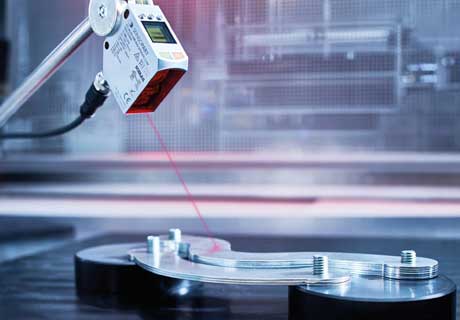What is the Frequency of a Photoelectric Sensor?
Key Takeaway
The frequency of a photoelectric sensor typically ranges from 10 Hz to 1 kHz, indicating how frequently the sensor can emit and detect light signals. This frequency range is crucial for determining how quickly the sensor can respond to changes in its environment, making it suitable for various dynamic industrial applications.
Definition of Sensor Frequency
The frequency of a photoelectric sensor refers to the rate at which the sensor’s light source can switch on and off or send and receive optical signals. This rate is typically measured in hertz (Hz), and it dictates how quickly a sensor can detect and respond to changes in its environment. Understanding this fundamental characteristic helps in assessing how suitable a sensor is for a specific application, especially in dynamic settings where conditions change rapidly.

Importance of Frequency in Photoelectric Sensors
The frequency of photoelectric sensors plays a pivotal role in determining their suitability and effectiveness across various applications. In high-speed environments such as assembly lines or automated control systems, sensors with high frequencies are indispensable. These high-frequency sensors can detect objects almost instantaneously, allowing machinery to react in real-time. This rapid response is critical not only for maintaining operational efficiency but also for ensuring safety, as delays in detection can lead to accidents and system failures.
On the other hand, in applications where the pace is more moderate, such as in material handling or batch processing, lower-frequency sensors may be more appropriate. These sensors still perform reliably but consume less power and can be more cost-effective. Using lower frequencies in such settings provides a perfect balance, optimizing performance without the unnecessary expense of high-speed detection that isn’t needed. The choice of frequency thus directly impacts both the efficiency of production processes and the long-term sustainability of the sensor system.
Average Frequency Ranges and Their Applications
The frequency range of photoelectric sensors is a critical specification that varies significantly depending on the intended use, typically spanning from a few hundred hertz to several kilohertz. High-frequency sensors, operating around 1 kHz or more, are essential in dynamic environments like packaging and sorting facilities. Here, the rapid movement of conveyor belts demands quick response times to ensure that every item is detected and sorted accurately, without any lag that could disrupt the flow or lead to errors.
Conversely, in more measured and controlled settings, such as electronic component assembly, the required frequency may be much lower. In these environments, the speed of object movement is less intense, allowing for the use of sensors with lower frequencies. These sensors are not only adequate for the task but also more energy-efficient and cost-effective, avoiding the overuse of high-frequency detection where it is unnecessary. This tailored approach to frequency selection ensures that each application uses a sensor that best meets its operational tempo, optimizing both performance and resource use.
Factors Affecting Frequency Selection
Selecting the appropriate frequency for a photoelectric sensor is a nuanced decision influenced by multiple factors that impact its efficiency and accuracy. Primarily, the specific demands of the application dictate the required frequency. Operations involving fast-moving objects, such as high-speed manufacturing lines, necessitate sensors with higher frequencies. These sensors can quickly capture and process changes in their field of view, ensuring real-time accuracy that keeps pace with rapid production processes.
Environmental conditions also play a significant role in frequency selection. Ambient light and electrical noise can severely disrupt sensor performance, particularly if the frequency of these interferences aligns closely with that of the sensor. To mitigate such disturbances, choosing a frequency that minimizes susceptibility to environmental noise is crucial. This might mean opting for a frequency that is distinctly higher or lower than the predominant environmental frequencies.
Moreover, the physical distance between the sensor and the target must be considered. Longer distances can lead to signal attenuation, where a sensor’s light beam weakens before reaching the target and returning. To combat this, lower frequencies, which are generally more robust over longer ranges, are recommended. They provide more stable signal detection and processing under such conditions, ensuring reliable performance even when the sensor and target are far apart. These considerations ensure that the chosen frequency optimally aligns with the operational, environmental, and spatial demands of the application, enhancing the sensor’s effectiveness and the overall efficiency of the system.
Optimizing Frequency for Specific Applications
To optimize a sensor’s frequency for particular applications, consider both the operational demands and the physical setup. In automated quality control systems, for instance, higher frequencies can provide more data points for evaluation, leading to more precise quality assessments. Implementing frequency filters or choosing sensors with adjustable frequency settings can also help tailor the sensor’s performance to the application’s specific needs, enhancing both accuracy and reliability.
Conclusion
Selecting the appropriate frequency for a photoelectric sensor is a critical decision that impacts the efficiency and effectiveness of industrial automation systems. By understanding and evaluating the factors that influence frequency choice and its implications on sensor performance, you can ensure that your selection not only meets the immediate needs of your application but also provides the flexibility to adapt to future challenges. Remember, the right frequency setting enhances the sensor’s responsiveness and precision, making it a cornerstone of successful automation strategies.
